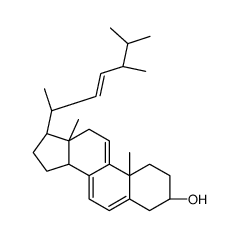Dehydroergosterol

Dehydroergosterol structure
|
Common Name | Dehydroergosterol | ||
|---|---|---|---|---|
| CAS Number | 516-85-8 | Molecular Weight | 394.63200 | |
| Density | 1.02g/cm3 | Boiling Point | 520.6ºC at 760 mmHg | |
| Molecular Formula | C28H42O | Melting Point | 146°C (lit.) | |
| MSDS | Chinese USA | Flash Point | 221ºC | |
| Symbol |

GHS08 |
Signal Word | Warning | |
|
Lipid droplet changes in proliferating and quiescent 3T3 fibroblasts.
Histochem. Cell Biol. 129(5) , 611-21, (2008) Lipid droplets (LDs) are fat-storing organelles present in virtually all eukaryotic cells and involved in many aspects of cell biology related to lipid metabolism and cholesterol homeostasis. In this study, we investigated the presence of LDs in proliferating... |
|
|
Spatiotemporal analysis of endocytosis and membrane distribution of fluorescent sterols in living cells.
Histochem. Cell Biol. 130(5) , 891-908, (2008) Distribution and dynamics of cholesterol in the plasma membrane as well as internalization pathways for sterol from the cell surface are of great cell biological interest. Here, UV-sensitive wide field microscopy of the intrinsically fluorescent sterols, dehy... |
|
|
Quantitative assessment of sterol traffic in living cells by dual labeling with dehydroergosterol and BODIPY-cholesterol.
Chem. Phys. Lipids 164(3) , 221-35, (2011) Cholesterol with BODIPY at carbon-24 of the side chain (BCh2) has recently been introduced as new cholesterol probe with superior fluorescence properties. We compare BCh2 with the intrinsically fluorescent dehydroergosterol (DHE), a well-established marker fo... |
|
|
The role of ABC proteins Aus1p and Pdr11p in the uptake of external sterols in yeast: dehydroergosterol fluorescence study.
Biochem. Biophys. Res. Commun. 404(1) , 233-8, (2011) Uptake of external sterols in the yeast Saccharomyces cerevisiae is a multistep process limited to anaerobiosis or heme deficiency. It includes crossing the cell wall, insertion of sterol molecules into plasma membrane and their internalization and integratio... |
|
|
Regulation of sterol transport between membranes and NPC2.
Biochemistry 47(42) , 11134-43, (2008) Niemann-Pick disease type C (NPC) is caused by defects in either the NPC1 or NPC2 gene and is characterized by accumulation of cholesterol and glycolipids in the late endosome/lysosome compartment. NPC2 is an intralysosomal protein that binds cholesterol in v... |
|
|
The fluorescent cholesterol analog dehydroergosterol induces liquid-ordered domains in model membranes.
Chem. Phys. Lipids 159(2) , 114-8, (2009) The fluorescent sterol dehydroergosterol (DHE) is often used as a marker for cholesterol in cellular studies. We show by vesicle fluctuation analysis that DHE has a lower ability than cholesterol to stiffen lipid bilayers suggesting less efficient packing wit... |
|
|
Chromatic aberration correction and deconvolution for UV sensitive imaging of fluorescent sterols in cytoplasmic lipid droplets.
Cytometry. A 73(8) , 727-44, (2008) Intrinsically fluorescent sterols, like dehydroergosterol (DHE), mimic cholesterol closely and are therefore suitable to determine cholesterol transport by fluorescence microscopy. Disadvantages of DHE are its low quantum yield, rapid bleaching, and the fact ... |
|
|
Fluorescence techniques using dehydroergosterol to study cholesterol trafficking.
Lipids 43(12) , 1185-208, (2008) Cholesterol itself has very few structural/chemical features suitable for real-time imaging in living cells. Thus, the advent of dehydroergosterol [ergosta-5,7,9(11),22-tetraen-3beta-ol, DHE] the fluorescent sterol most structurally and functionally similar t... |
|
|
Free-cholesterol loading does not trigger phase separation of the fluorescent sterol dehydroergosterol in the plasma membrane of macrophages.
Chem. Phys. Lipids 154(2) , 129-36, (2008) Accumulation of excess non-esterified free cholesterol (FC) in macrophages is a key factor in macrophage death during late stages of atheroslerosis. Raising FC content in macrophages has been shown to trigger Rac activation and actin polymerisation and to inh... |
|
|
Sterol superlattice affects antioxidant potency and can be used to assess adverse effects of antioxidants.
Anal. Biochem. 382(1) , 1-8, (2008) We have developed a fluorescence method to examine how membrane sterol lateral organization affects the potency of antioxidants, and used this information to evaluate possible adverse effects of lipid-soluble antioxidants seen in recent clinical studies. In t... |